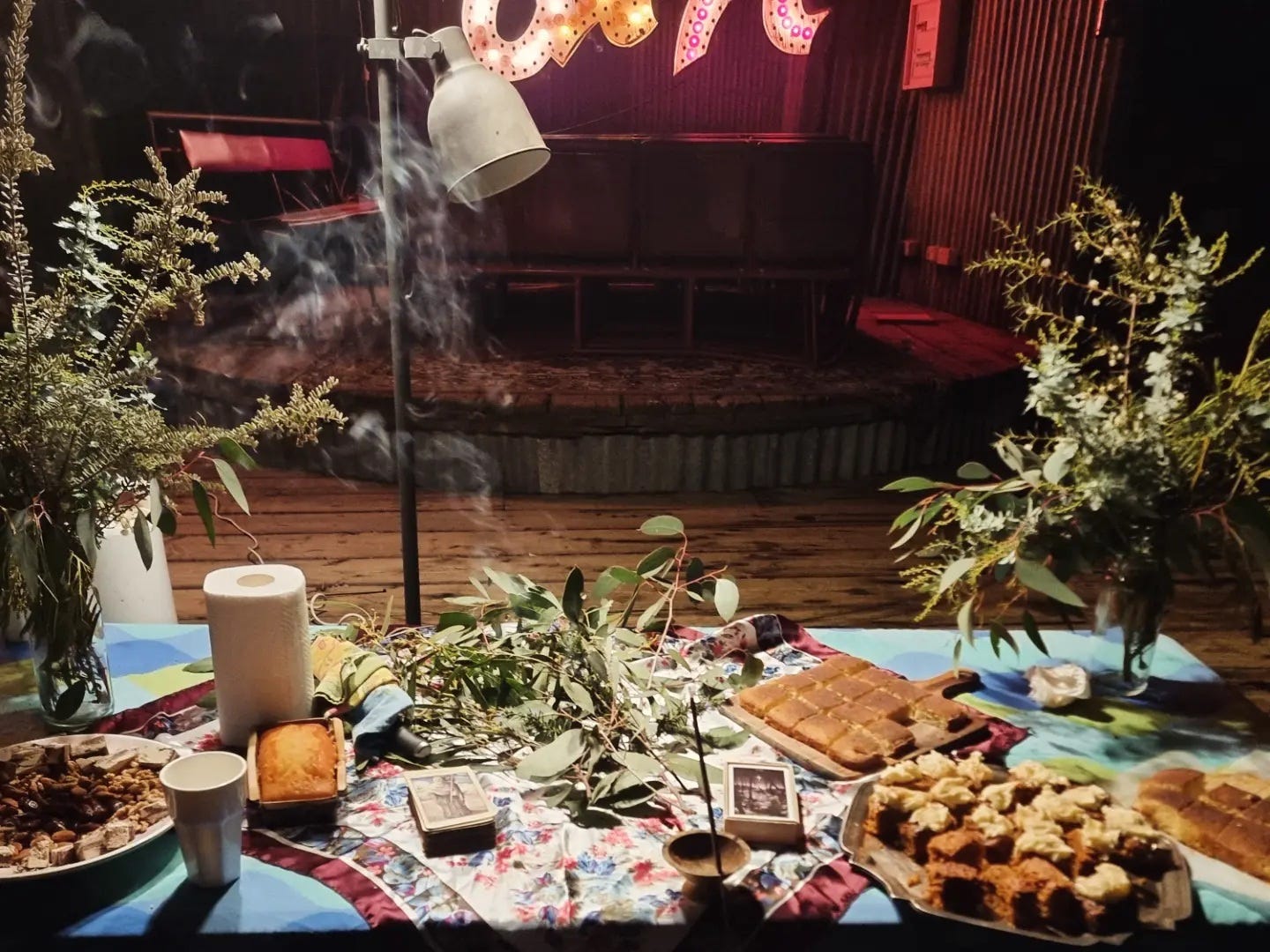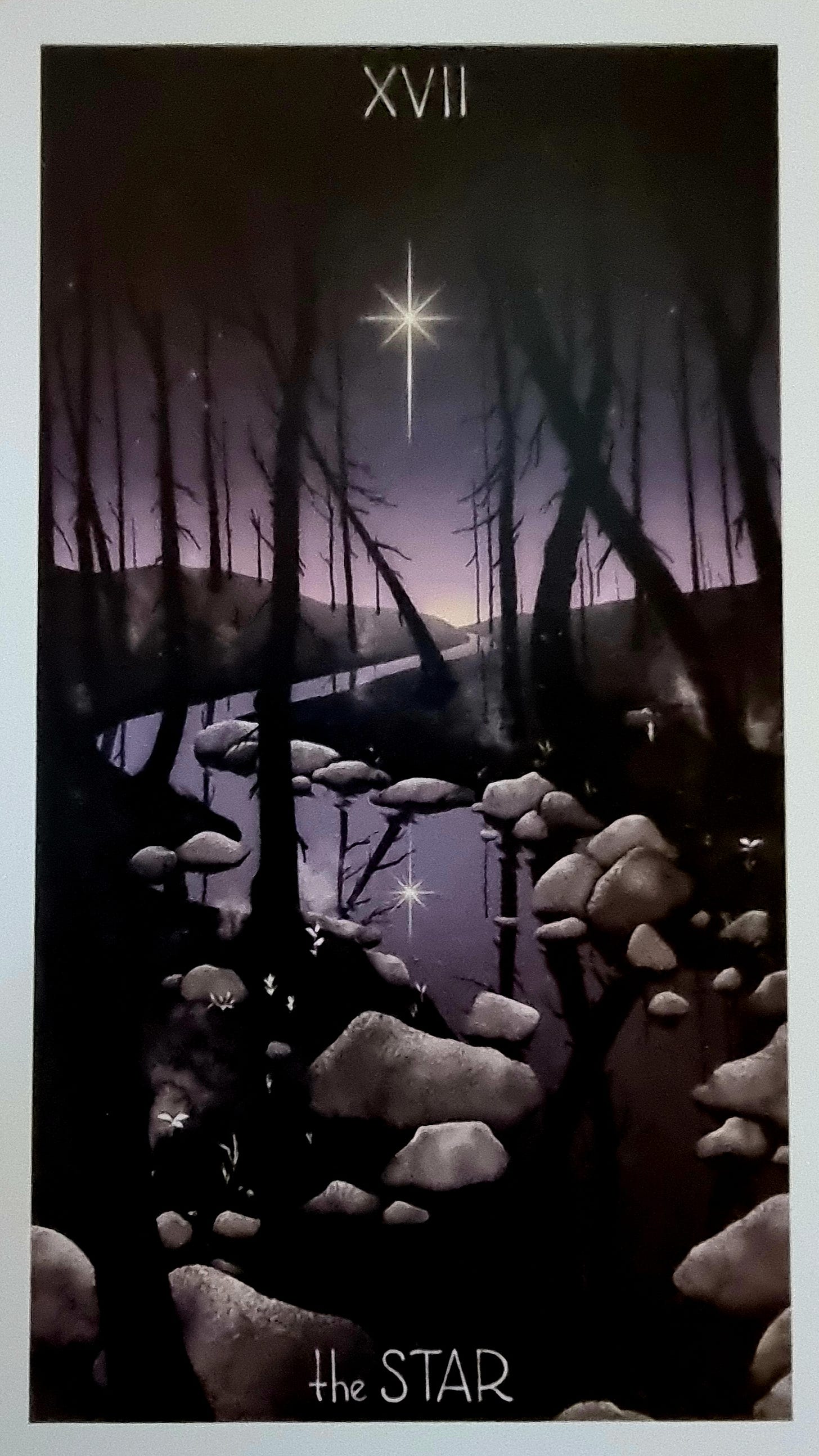Earlier this year I packed up my possessions and moved thousands of kilometres across the continent. The decision was a confluence of factors; love, boredom, adventure, fear. For 5 months now, the flesh of suitcase of my body, packed with billions of microscopic lifeforms, has been unfurling itself on new land, adjusting to new soil, new food, new air and new seasons.
One of my greatest fears in moving to the southern latitudes was winter and the lack of light. Last time I was 'south' I hurtled through months of low skies and feeble sunlight, my depression closer than the bodies of my fellow commuters on the peak hour train. I worried that the black dog would once again turn savage, bearing it's teeth at my throat while I lay paralysed in bed.
It was for this reason, along with the gaping wounds of the world screaming through my phone on my daily scroll, that I began to seek talismans for navigating in the dark. By 'the dark' I mean literal days with scant sunshine, and figuratively, times of unknowing. As I walked through my own unknowing, I sought solace in my tarot deck, and that was how I encountered the idea of the lantern.
My brain has tricky wiring. It is easy for me to get overwhelmed. In these months of ‘many things to do and remember’ it has been helpful to focus on what is in front of me. Encountering The Hermit card one day, I was reminded of the important lesson they teach about paying attention to what is in front of you. Away from the comforts of the village, The Hermit travels through the darkness, with only the light of their small lantern. Now a lantern will help keep you from a falling in a ditch, but it will not help you see much further than that. I got to thinking about how the world, in this death cycle of colonial capitalism, we are Hermits, navigating the dark with a small lantern that will only allow us to see two feet in front of us. It is hard, impossible even, for us to see a future, and yet we must continue to move forward and try to stay out of the ditch.
As I travelled with the Hermit and their lantern, I witnessed pain around me everywhere; the horror of genocide in distant places and up close in places I’ve lived. I began to wonder what could help make sense of so much destruction. In the Major Arcana of the tarot, The Star appears after the Tower, a card of collapse where so much of what we’ve known and built falls away. Standing in the ruins of The Tower, where everything familiar has fallen away, and we turn toward The Star and begin to make our way.
As I witnessed the growing movements of university encampments, I thought about the value of big ideas and ideologies that guide us through generations towards liberation. In the university encampments I saw people experimenting with different ways of being together in the face of increasing state violence and authoritarian condemnation. I continue to witness countless creatives and community organisers establish small hospices in the ruins of modernity. I have been fortunate to be a part of some of these, as an artist and as an activist. I know what they do for the soul.
But I also know that these spaces are often fleeting; that our wins can soon be undone, and the disappointment that can overwhelm when we fail to make our visions manifest. I got to thinking about how The Star is not grounded, that it is not something we can reach. It’s light beams into our life from unfathomable distances, from times and places that have passed. And yet, despite the distance, we turn towards it. It guides us on our way. The Star made me think how we are all ancestors and descendants with a role in trans-generational struggles. How we must remember that liberation takes lifetimes, that ideas travel far to reach the earth.
Thinking alone is like a deflated balloon. My ideas need people. In the depths of grappling with post PhD feelings of failure, I recovered the pearl of thinking with others through a community philosophy practice. I began to try out the idea of using The Hermit and The Star as archetypes to guide us trough uncertain times. First over the dinner table, and then over Zoom with a group of rag tag thinkers from The Long Table, I learned the metaphor worked for others, that the story was sturdy enough to be put to work.
Hosting an event is always an experiment. In late May I cast out an invitation to my local community to gather around a fire at Solstice and explore the metaphor of the lantern and the star. On winters solstice, some 24 souls gathered, friends brought cake and I made chai. Folks from Lot 19, who hosted the event, helped make a fire and set up lights. I built a small altar of blossoms and branches collected with a new friend. It was freezing and we gathered close for warmth, and people did the thing that always amazes me when I host events; they showed up with their full selves.
I don’t like taking too many photos or recording community philosophy events. I worry that it breaks the intimacy of the circle. But I do want to share some the insights that have stuck with me, because I think that finding different ways to think about the times we are in is important. Like stars these snippets are distant transmissions of something that happened some time ago. Like a lantern, they illuminate a small part of what happened, but perhaps they can help you find your way.
How do we pay attention to what fuels our lantern?
Is it anger? Hope? Joy?
Sometimes we need to turn away
from the bright lights of the city/modernity,
to see the stars, to be guided by our own lantern/s.
A lantern makes you visible to others; we become each others lantern.
This reminds us we are not alone, and helps us see each other.
We may not always realise how much we are a guide posts for each other.
Constellations of stars in the sky.
Constellations of lanterns on the ground.
We are in relationship.
Being lit up by the light of our mobile phones. Is this our lantern?
The stars remind of us of different time scales;
how many civilisations have they seen rise and fall?
The Lantern and The Star. They are not different.
They are the same thing.
Country unfolds beneath the lantern.
It is always there, but we can feel like
we are discovering it, because it's too big
for us to grasp all at once.
In his essay, Childish Things, Dougald Hine reflects on the value of small, regular, collective cultural practices through the analogy of ‘The Sunday Service’. After years of striving, I keep returning this idea of humble, regular practices. As I anchor into a new place, and try to bring more sustainability into my practice, I’m committing to presenting a series of four community philosophy workshops, held on the cross quarters of the year, that use the seasons as a starting point for thinking.
The Lantern and The Star, was the first of these workshops, held on the winter solstice. The next, to be held in September, on the Spring Equinox, is bringing forth ideas of resilience facilitation, and paying attention to what grows. These workshops will be in person, on Jaara land, but I will be following each of these up a newsletter, to share the ideas and reflections. If you’d like to read along at home, I’d love to have you along for the ride. If this post has found you, and it’s not your flavour, please click unsubscribe.
Until then, go gently
Kelly Lee Hickey
Tarot Image Credits:
The Hermit, The Mythic Tarot Deck, Julia Sharman-Bourke and Liz Greene
The Star, The Way Home Tarot Deck, Bakara Wintner and Autumn Whitehurst
You have received this email as you have engaged with my work through a workshop or event. This newsletter will come out quarterly, and if it is not for you, please feel free to unsubscribe.






